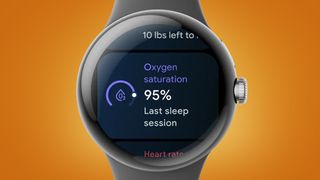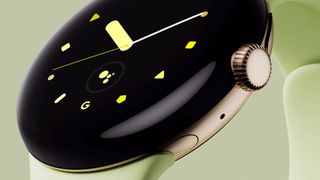Your Google Pixel Watch just got a long-awaited health feature
SpO2 monitoring has finally landed on the Pixel Watch

Update June 13, 2023: It's official! Google has now announced the arrival of SpO2 monitoring on the Pixel Watch, alongside other features.
Your Google Pixel Watch just got a big update that lets it show your blood oxygen levels (SpO2), which means it's now a better health tracker and a rival to the world's best smartwatches.
Earlier today, the Pixel Watch update was spotted by a Reddit user, which suggested that a wider rollout was en route. And sure enough, Google's watch has finally got a feature that many of its smartwatch rivals already offer, albeit in a different form.
The Reddit user earlier today was able to access what was then an unofficial tool in the Fitbit Today app. By tapping on a dedicated Oxygen saturation option hidden at the bottom of a menu, they got a readout of the SpO2 reading from their last sleep session and info on on how to interpret the data.
This shows how differently the Pixel Watch's SpO2 feature works compared to rivals like the Apple Watch 8. Rather than relying on manual readings, with Google's system works in the background while you're sleeping.
SpO2 monitoring is a smartwatch feature that uses sensors to detect your blood oxygen saturation. By shining red and infrared light into your skin, and then detecting how long it takes for the light to travel back to the Watch, the sensor’s can determine your blood’s oxygen levels.
Anything above 95% is normal, while people who have conditions like chronic lung disease or sleep apnea should expect to see readings of 90% or above. If your reading unexpectedly dips below 95% you should consult your doctor as it could be a sign of a health condition.
Get daily insight, inspiration and deals in your inbox
Sign up for breaking news, reviews, opinion, top tech deals, and more.
Alongside the SpO2 update, the Pixel Watch has also been given some other new features. These include the ability to send you a notification if your heart rate is unusually high or low, plus auto-pausing workouts that will stop its tracking if you need to take a quick breather.
Why has it taken so long?

Typically, this kind of monitoring feature would arrive via hardware change rather than software, but the Pixel Watch is a special case.
The reason we didn't need to wait for a Pixel Watch 2 to add SpO2 monitoring is because the current model has all of the necessary monitors, it just doesn’t use them at the moment.
It isn't clear why Google waited so long to turn on the feature, but it's most likely related to health tech regulations in certain regions. It could also be that while Google’s gadget has the appropriate hardware, Google needed more time to calibrate it using software to make it accurate enough for use.
Given how serious managing people’s health is, regulators and Google wanted to be certain that the Pixel Watch’s SpO2 monitoring is as robust and reliable as possible before releasing it to the public.
Whatever the reason for the feature not being turned on, the arrival of SpO2 monitoring alongside other features are a big boon for Pixel Watch owners – even if they've had to wait a while to get them.

Hamish is a Senior Staff Writer for TechRadar and you’ll see his name appearing on articles across nearly every topic on the site from smart home deals to speaker reviews to graphics card news and everything in between. He uses his broad range of knowledge to help explain the latest gadgets and if they’re a must-buy or a fad fueled by hype. Though his specialty is writing about everything going on in the world of virtual reality and augmented reality.
- Mark WilsonSenior news editor
Most Popular


